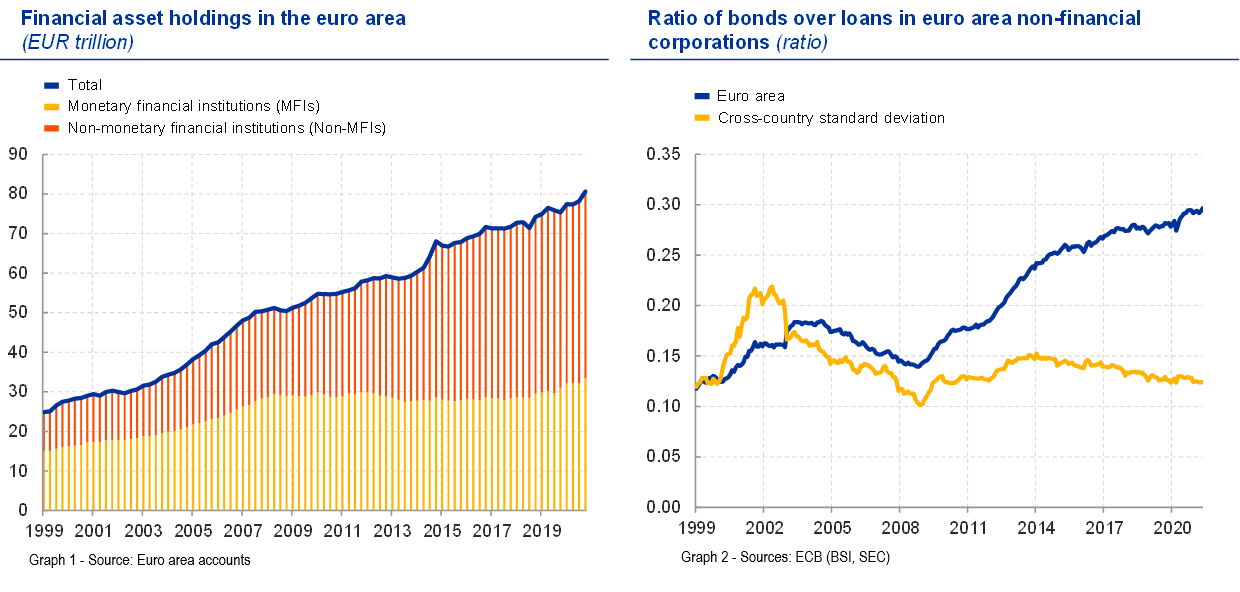Direct lending: Everything You Need To Know

History has shown that crises and disasters pave the way for change, more often positive. What matters is how someone perceives it, and that makes the big difference.
For sustainable businesses with healthy management, a recession can really be an opportunity for them to thrive and grow.
In order to grow, companies that face the new situation have to maintain the level of trust from the market (customers, suppliers etc,) and to ensure the required liquidity.
Direct lending through private financing
In Eurozone and other countries, bank loans are not the only financing solution. The largest percentage of funds for business financing in Europe comes from Direct Lending through Private Investment Funds (Graph 1).
Direct lending is financing that does not come from a banking institution (bank) but from private funds as business financing.
Private Investment Funds are the accumulated liquidity of individuals or companies, which are placed in to companies, not listed on the stock exchange, in order to maximize the return on investment in the long run.

Categories and forms of direct lending through private financing
The categories and forms that private equity financing can take depend on the purpose for which they will be used.
The main categories are funds with the purpose of:
- Developing a new business activity (startups).
- Restructuring and consolidation of sustainable enterprises with accumulated debts (Distressed funds).
- Business development or investments through Mergers & Acquisitions.
- Working capital.
Forms of financing can take the following forms:
- Working capital, with a specific repayment period.
- Long-term loan for debt restructuring and acquisitions.
- Non-convertible bond loan, by issuing bonds and retairning them with repayment.
- Convertible bond loan, by issuing bonds and retairning them with repayment or conversion into shares and participation in the company ownership through a pre-agreed procedure.
- Participation in the company ownership with a percentage in the share capital greater than 1/3 and participation in the Management.
- Participation in the company ownership with a percentage in the share capital of less than 1/3 without participation in the Management.
- Full ownership of the company.
All of the above take the form of a pre-agreed procedure, which includes obligations and commitments for both parties.
Factors that determine the cost of financing from private funds
The cost of funding depends on the characteristics of each case separately and in particular on:
- The type & form of funding as mentioned above.
- The financial situation of the company being financed.
- The financial forecasts of the company during the settlement.
- The overall level of risk that the investor is willing to undertake.
- The total amount of invested funds.
In addition to the above, financing of this form is charged with taxes and fees.
Forms of companies that can be considered for funding
The funded company must have a legal form and ie, the form of a Societe Anonyme, a Limited Liability Company or a Private Capital Company.
Terms and conditions of financing through private funds
The purpose of a private investment fund is to achieve the greater return on investment through placements that usualy take place in the global market.
These funds are considered investment on the grounds that they are placed in healthy businesses or viable businesses that are going through a crisis for various reasons and have accumulated debts.
In order to participate, a private investment fund examines:
- The potential of converting its funds in to surplus value for the company it invests in.
- Whether it can get higher returns compared to the banking sector.
- Companies with sustainable activity that are organied and operationally complete.
Private investment funds are not speculative since they seek to profit by selling the surplus value they will provide. They seek to contribute to the development of a company, through their know-how or the profesional network they have in specific business sectors. That makes the investor selection process in itself, a process that needs specialized knowledge usually by adressed to a consultant.
Ground preparation for financing
In order to br financed from private funds, the company's management has the obligation to prepare it, giving it the required characteristics.
Everything should be included in a comprehensive B-plan with measurable, trackable targets, and Cash Flow Analysis. In summary, the characteristics required are:
- Clear business identity.
- Effective management team.
- Defined and complete internal organization.
- Proven existing operational viability (only for existing companies).
- Ongoing future operational viability (forecasts).
- Adoption of information transparency.
- Comprehensive and specific B-plan with thorought financial projections.
Benefits and restrictions of direct lending from private funds
Benefits
- Promotes the recognition, reputation and extroversion of the company.
- Creates alternative financing methods, in combination with other sources.
- Creates internal organizational discipline, in relationships with suppliers, customers & third parties.
- Attracts better executives.
- Implements corporate governance methods, with modern administrative structures and principles of transparency.
- Forms the conditions for continuous and current valuation.
- Can offer an exit strategy for the initial shareholders.
- Greater flexibility compared to banking institutions.
- Risk-taking where banking institutions can close the door.
- Basic security through sustainability, without collateral or guarantees.
- Access to the investor's network.
Restrictions
- Higher financing costs compared to banking institutions.
- Cannot deviate from agreed terms without prior agreement.
The comparison of benefits with restrictions suggests that when a private fund participates at the right time, under the right conditions with the right preparations, constraints such as higher borrowing costs are overshadowed by the surplus value the fund can provide to the company.
When should a company consider approaching a private investment fund?
Like any form of financing, financing from private funds is not always suitable for all businesses. It must be a well-thought-out decision.
In general, every business should consider this alternative when:
- The initial shareholders wish to be paid the surplus value they have given to the company (Exit Strategy).
- The company does not have access to banking institutions for a loan. This happens when a bank does not want to take risks by participating, most likely when there is:
- Recent rapid growth.
- Sustainable and promising activity, but unsustainable operation for various reasons or circumstances.
- Historical debt default.
- Newly established company without a history.
- Shareholders want to further develop their business by gaining reputation, new know-how, new connections or even new clientele through the capabilities of a new partner.
- The company wants to repay prior accumulated debt.
- The company wants to acquire competitors.
- There is an innovation at its initial stages of operation (startup) seeking financing without the risk of personal guarantees.
The role of the consultant for financing from private investment funds
For a viable and growing business, choosing a team of professional consultants can really be an opportunity for them to thrive and grow.
The characteristics of the consultant should include adequacy of knowledge and experience, immediacy of the proposed solutions, experience in negotiations and their tactics and access to private investment funds.
A key condition for the success of a deal with a private investment fund is the trust of both parties to the consultant, his participation in the implementation and his personal presence to improve and facilitate the deal.
What we have to offer
Sell-side
- Identifying, short-listing and facilitating engagements with strategic investors and creditors.
- Pursuing mergers, acquisitions, and partnerships within and across borders in developed and emerging markets.
- Analyzing shareholder alternatives.
- Assisting clients in evaluating proposals and negotiating up to deal closure.
Buy-side
- Identifying and approaching potential acquisition targets on behalf of clients.
- Facilitating introductions to key targets and partners in both developed and emerging markets.
- Evaluating and arranging financing alternatives.
- Assisting in negotiation, structuring and deal-closing with the seller and financing providers.
| This article intends to inform the reader and in no way substitutes the specialized consulting services. For more information, please contact MDC Stiakakis SA (Monis Kardiotisis 49, Heraklion | +30 2810 280985) |


